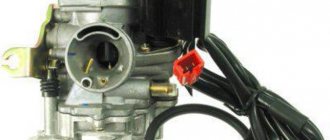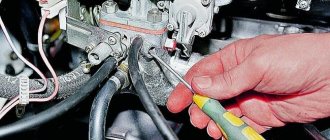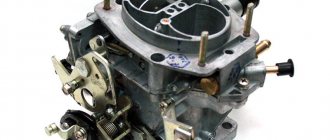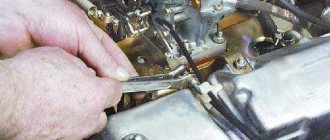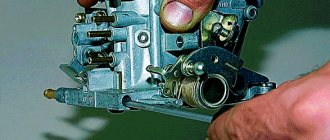The Solex carburetor (DAAZ) is one of the most popular devices in the list of carburetor metering systems, since with the right approach it is possible to flexibly configure carburetors of this type. For this reason, car enthusiasts install Solex carburetors on different engines, after which they are further adjusted, achieving the required fuel efficiency indicators, quality of mixture formation at power and other operating modes of the internal combustion engine.
We also recommend reading the article on how you can do carburetor tuning yourself. From this article you will learn about various ways to independently modify carburetor metering systems.
After installing Solex on the engine, it is often necessary to configure this device. To solve the problem, you can contact a service center, where a specialist in setting up the carburetor will perform all the necessary operations. You can also adjust the carburetor yourself. In this article we will talk about how to adjust the quality of the mixture on a Solex carburetor, how to adjust the fuel level and adjust the float chamber of the Solex carburetor, adjust the idle speed, etc.
Messages [20]
1↑ Topic from PATRIOT 03/25/2013 14:32:03
- PATRIOT
- Patriot IMZ
- Inactive
- Name: Ilya
- From: Krasnodar region, Krasnodar
- Registered: 18-02-2011
- Messages: 3 148
- Reputation: 177
- Motorcycle: No. Next will be the K750!
Topic: Carburetor adjustment (mixture quality) for beginners!
I think once again it will be useful for beginners to read about adjusting the quality of the mixture, and even the carburetor itself. As already noted, the quality of the mixture at different crankshaft speeds is adjusted differently:
for small ones, use the “quality screw” of the idle speed system;
at medium - with a throttle needle;
at maximum - with the main fuel jet.
Before proceeding with the adjustment, it is necessary to determine the quality of the mixture in various modes by external signs of engine operation. Signs of working on a lean mixture are popping sounds in the carburetor, a drop in power (deterioration of throttle response, drop in maximum speed). Signs of running on a rich mixture are black smoke from the exhaust at maximum speed, popping noises in the muffler, and poor engine response.
In addition, the quality of the mixture can be determined by the color of the spark plug insulator:
with normal mixture quality, the color of the insulator is brown,
with a lean mixture, the color of the insulator is whitish-gray or light brown,
with a rich mixture, the color of the insulator is dark brown or black.
Carburetors are adjusted on a warm engine. If the carburetor is adjusted on a cold engine, then when the engine warms up, it will be disrupted, since the volatility of gasoline in contact with heated parts will change and the quality of the mixture will change accordingly.
The left and right carburetors are adjusted separately. To do this, place the motorcycle on a stand and start the engine (to facilitate starting on two cylinders). On the carburetor cylinder that is not being adjusted, remove the tip from the spark plug and short it to ground. If the tip of the spark plug is not connected to ground, the process of spark formation in a working cylinder will be difficult, especially with discharged batteries. In this case, the engine will operate at an increased speed and the carburetor adjustment will be inaccurate. Next, you need to make sure that there is a gap between the cable sheath and the stop on the carburetor. If there is no gap, ensure it by screwing in the stop.
Then adjust the mixture quality at idle. To do this, you need to unlock the idle quality and quantity screws. Screw the “quality screw” 22 (Fig. 5.4) all the way and use the “quantity screw” to set the minimum stable crankshaft speed. Then slowly turn out the quality screw. In this case, the over-enriched mixture begins to become leaner, but will still be rich. When the mixture composition corresponds to the norm, the rotation speed will increase.
As you further turn out the quality screw, the mixture will become leaner, the rotation speed will not increase, and if the mixture becomes too lean, popping noises will appear in the carburetor, so during the adjustment process, turn the quality screw out until the rotation speed increases. It is difficult to determine from the first time at what position of the quality screw the increase in rotation speed stops, so it is advisable to repeat the adjustment operation 2 - 3 times. Turning out the screw, notice when the increase in rotation speed stops. Having finally established the required position, lock the screw. After adjusting the quality of the mixture at idle using the quantity screw, reduce the engine crankshaft speed to the minimum stable speed. After one carburetor has been adjusted, the second one must be adjusted in the same way. Then, with the engine idling, you must alternately remove the caps from the spark plugs of the left and right cylinders and check by ear whether the crankshaft rotation speeds are the same when operating on the left and right cylinders. If the frequencies are not the same, then you need to use the quantity screw, increasing or decreasing the rotation speed, to restore the balance.
This is interesting: How to disassemble a bicycle fork with a shock absorber
After adjusting the quality of the mixture at idle, adjust the quality of the mixture at average speed. But first it is necessary to check the quality of the mixture by sharply “opening” the throttle. If at the same time popping sounds appear in the carburetor or “dips” in engine operation (flashes in the cylinder stop; at the same time, if the throttle is “opened” smoothly, the engine gradually picks up speed), then the mixture is lean. If the engine speed begins to increase slowly, the mixture is rich, if quickly, the quality of the mixture is normal.
The quality of the mixture at average speed is regulated by the throttle needle. If the mixture is lean, you need to move the needle lock to a lower groove so that the needle rises. If the mixture is rich, you need to lower the needle, move the lock to a higher groove.
What does the quality screw on the carburetor do?
After TURNING the screw to about 10 revolutions, the spark plugs became light brown (dark yellow) in color.
When the screw is turned out, air passes from the pre-throttle space of the first chamber to the bushing - the nozzle of the idle system, located in the pre-throttle space. If the quality screw is screwed in all the way, then the mixture is formed passing the idle jets. The mixture quality screw regulates the supply of ADDITIONAL air to the outlet channel, where the already formed mixture enters.
Of course, the question of increasing the speed when unscrewing the screw is interesting. But personally, I can explain this in such a way that when the screw is opened, due to the vacuum in the throttle space, the air flow accelerates, which in turn causes a higher flow of gasoline through the idle jet. That is, more of the mixture enters the throttle space compared to a fully screwed screw, but the mixture itself is POORER. That is why turnover is growing. Andrey. PS. Why are we already on “YOU” again?
Unfortunately, as established experimentally, at 113 carbs the plant made an UNDOCUMENTED change to the mixture quality control system. At 111, twisting leads to a leaner mixture, and at 113, to a richer mixture.
Economical and stable engine operation in most cases depends on the fuel level in the carburetor float chamber and the idle speed of the crankshaft, as well as on the proper operation of the carburetor.
The carburetor is adjusted to a low crankshaft rotation speed in idle mode with the engine running, warmed up to a temperature of 80-85 degrees Celsius, with the electrical system devices in working order, the timing belt adjusted and the air damper fully open.
Adjusting and tuning the carburetor: main steps
Most modern gasoline cars are equipped with fuel injection systems, but before they gained dominance, all cars were equipped with carburetor systems. For this system to work correctly, the carburetor settings must be performed flawlessly. High-quality carburetor adjustment will reduce fuel consumption, make the engine run smoothly at idle, reduce the emission of harmful substances into the atmosphere and increase the overall engine life.
Most domestic cars have a carburetor system, and the question of how to adjust the carburetor will not lose its relevance for a long time. Many owners of rare old foreign cars also face the problem of how to adjust the carburetor. Since the principle of operation of carburetors around the world is no different, the algorithm of work will be the same.
The carburetor is the main component of the fuel system of any carburetor car. This is where air and fuel mix to form a fuel mixture that enters the engine's combustion chambers. A properly adjusted carburetor produces a fuel mixture in the required proportions. Such a mixture will not detonate in the cylinders, which will increase the life of your engine.
A little about Solex and its design
Carburetors have long been replaced by injection systems. But they are still found in cars driving on Russian roads - in old foreign cars and VAZs produced 20 years ago or more. Before the release of VAZs with injection engines, a number of models were equipped with a Solex carburetor, and interest in it does not dry up.
Adjustment of the Solex carburetor installed on the engine is usually done at a car service center. But, if you wish, you can adjust the device yourself - adjust the quality of the fuel-air mixture (FA) and adjust the Solex float chamber. Solex prepares the fuel assembly and supplies it to the engine in the required volume.
How Solex works:
On a note! The operation of the Solex carburetor uses one diffuser chamber or two - this depends on the operating mode of the car engine.
How to adjust the carburetor and when to do it
Do-it-yourself carburetor adjustment is done after using low-quality gasoline or when engine operation is no longer stable. For prevention, the manufacturer recommends flushing the carburetor with a special compound every 6-7 thousand kilometers.
Possible malfunctions in the carburetor:
- Fuel leaks on the carburetor. In this case, you need to measure the fuel pressure. This is done using a special pressure gauge. The operating instructions will tell you what the pressure should be. Typically it ranges from 0.2 to 0.3 atmospheres. If the pressure is normal, the problem is in the float chamber and the fuel level needs to be adjusted;
- Carbon deposits on spark plugs with the smell of gasoline. This clearly indicates a problem with adjusting the carburetor floats or a burnt valve;
- Rough engine idling may not only be due to the carburetor. This often happens due to incorrect adjustment of the throttle cable. To check, you need to disconnect the cable and turn the valve manually.
Before you adjust the carburetor correctly, you need to clean it thoroughly. It is recommended to use special liquids for cleaning. The jets cannot be cleaned with toothpicks or needles. Damage to the jets will lead to calibration failure. If the holes cannot be cleaned with aerosols, you can carefully clean them with a soft wire. When cleaning, do not use rags. Threads can clog the holes, which will lead to malfunction of the carburetor. If the aerosol does not remove all contaminants the first time, you need to repeat the procedure.
How to adjust the gasoline level
Setting up the carburetor begins with setting the gasoline level in the float chambers. It is recommended to align it along the floats to the carburetor cap. For this purpose, you can use a template, but practice shows that this method produces errors, especially when excess fuel gets into the carburetor.
How to accurately adjust the fuel level in the carburetor and adjust its floats:
If the level after adjustment is still different from the norm, you have to repeat the adjustment. Please note that you cannot adjust the level with the engine turned off and manual pumping - if the engine is started, there will still be overflow in the carburetor. This especially applies to engines with a blocked return flow.
Setting up the float mechanism
The level of the fuel mixture in the float chamber is directly related to its quality. At an increased level, the mixture will turn out to be lean, which will negatively affect gasoline consumption and increase toxicity. Without adjusting the floats, the question of how to adjust the carburetor cannot be solved. The process of adjusting the floats includes the following operations:
- Adjusting the floats in relation to the lid and walls of the fuel chamber. If deformation of the float fixing bracket is noticed, it should be aligned manually;
- We adjust the bracket with the needle valve closed;
- We adjust with the float retracted and the valve open; the distance between the float and the valve should in this case be set to about 15 millimeters.
Adjusting the accelerator pump
Accelerator pump metering systems
The main task of the accelerator pump is to supply a smooth and powerful stream of gasoline through the open throttle valve of the carburetor (dripping and sluggish streams are not allowed). The stream of gasoline should enter directly into the manifold, without touching the walls of the diffuser and throttle valve.
Flowing of gasoline down the diffuser stack or throttle valve is not allowed, since the car will become very blunt and jerky when you press the gas sharply.
An accelerator pump with two spouts must be installed in different chambers. You can insert two spouts into the primary chamber - this can increase the agility of the car, but also lead to excessive “overflow”.
Setting the fuel mixture supply
The carburetor control screws will help you figure out this setting. Before performing this procedure, you should know that the screws have a plastic factory press-on that limits the rotation of the screws (from 50 to 70 degrees). If turning in this range does not bring results, you need to break the press-on and turn the screws as much as necessary. Before setting the position of the screws, you should warm up the car engine to operating temperature.
To adjust the idle speed of the carburetor, you need to turn out the quantity screw and the mixture quality screw a few turns and, turning them, listen to the operation of the engine. When the engine starts to run smoothly, the carburetor idle adjustment is complete.
How to adjust idle speed
Idle speed adjustment (IAC) is carried out when problems occur in the engine - if it does not start, stalls after starting and other problems. It is also recommended to perform IAC after replacing or repairing the carburetor.
For IAC you will need:
The optimal idle speed for engines with Solex is 750-800 rpm. Rotate the fuel mixture “amount” screw and set the crankshaft frequency indicated above. If you cannot set the desired speed, you will also have to adjust the “quality” screw of the fuel mixture.
On a note! There may be a plastic plug on the fuel mixture “quality” screw; before adjustment, it must be removed, pierced with an awl and pulled out with a hook or self-tapping screw.
XX adjustment is carried out three times. If there is no result, repeat it 2-3 more times. Before starting work, check whether the ignition is set correctly and the wiring is in good condition, and whether foreign air is being sucked into the carburetor.
Repeat the setup if necessary. If you are replacing an old carburetor with a new one, or you have disassembled or repaired it, then before you start adjusting, tighten the “quality” screw to the maximum, and then turn it out 3-4 turns.
Having completed the adjustment, step on the gas - the engine should increase the crankshaft rotation speed without failure, and when it is released, it should not stall. If there are “dips,” repeat the adjustment or turn the mixture “quality” screw. Increase the idle speed to 900 rpm. If you tighten the “quality” screw clockwise, the CO concentration is reduced to 1.5%.
Adjusting the carburetor draft
Before you begin adjusting the rods, you should remove the air filter cover so that nothing interferes with the process. First, using a caliper, measure the distance between the rod tips. According to factory parameters, it should be 80 millimeters. To adjust the length of the rods, you need to loosen their clamps.
Checking the strainer should be carried out when there is fuel in the float chamber. This will help you see if the shutoff valve is closing completely. After examining the valve, you need to clean and dry it. Problems with loss of power and engine failures occur due to obstructed fuel supply. This is another reason to thoroughly flush the carburetor.
The tightness of the shut-off needle can be checked using a rubber bulb, while listening for air leaks. If they are present, it is time to change the needle.
Basic faults
In order to make adjustments, you need to know several typical faults. Since this unit is responsible for dynamic characteristics, breakdowns include:
- Problems starting the engine, engine sneezing.
- Jerks, jerking, frequent failures on the accelerator pedal.
- Lack of overclocking options.
- Increased fuel consumption.
So, if while operating your car you were able to detect one or more faults from this list, then the part needs repair.
You need to know that the maximum adjustment of the DAAZ 2107 1107010 carburetor is possible only with the unit removed. The process does not involve cleaning this device with lint or woolen rags. You also won’t need any wires to clean the jets.
When making adjustments yourself, you must first remove the cover from the assembly. Then you can proceed to adjusting the float chamber. It's comfortable.
How to properly adjust a Solex carburetor
There are still many representatives of VAZ classics driving along the roads. Many of these cars have Solex carburetors under the hood. This carburetor is more economical and is capable of producing a higher quality mixture of fuel and air. For smooth operation of the engine, this carburetor must be properly tuned and adjusted. The class of carburetor masters is gradually dying out, so many people have to do the carburetor adjustments themselves.
Jets and accelerator pump
A nozzle (injector) is a device for supplying fuel in a certain amount. The engine draws in air through the opening of a large diffuser. At the same time, fuel is dosed through the nozzle. The amount of air sucked in through the diffuser, as well as the amount of gasoline drawn in, depends on the engine displacement. Because of this, on engines with large volumes, carburetors with small jets are installed.
In order for the jet to produce a normal fuel assembly, not lean, it is necessary to find a carburetor that was initially designed for a certain engine volume or as close as possible to it. First, select the fuel and then the air jet. They are selected for the first camera, then the second camera is configured.
The accelerator pump is necessary to supply additional fuel when the throttle is opened, this provides more efficient acceleration. The pump operates through a special cam mechanism. On engines with Solex, you need to install the largest possible cam for the accelerator pump.
How to set the ideal settings yourself
To work, you will need the usual set of tools that are found in almost every garage. To eliminate fuel overflows, you need to correctly set the float in the chamber. This operation can be done using a special template. Experts recommend not using this template, since the number and thickness of gaskets in carburetors do not always match. Fans of various improvements often replace factory gaskets with better ones. It happens that the factory settings of the template do not suit everyone. Although Solex carburetors are the same, the fuel pump can deliver gasoline differently. A lot also depends on whether the return line is plugged, so specialists use a different method.
- The mixture quality adjusting screw is tightened by hand until the end;
- Next, unscrew it back five turns;
- Turn on the engine, remove the choke and use the mixture screw to bring the engine speed to 750 rpm;
- By turning the quality screw, we bring the engine speed to the maximum;
- Using the quantity screw, reduce the speed to 800 rpm;
- We tighten the quality screw a little until instability appears;
- We unscrew the same screw back one turn;
- We turn the quantity screw until the idle speed reaches 800 rpm (in winter they can be raised to 900).
It is worth remembering that adjusting the carburetor not only eliminates floating engine speeds. A well-tuned carburetor will consume a minimum amount of fuel at stable idle speeds.
Various problems may arise with this adjustment.
It happens that when unscrewing the quantity and quality screws, the engine practically does not react. This happens when a large stream of gasoline flows from the idle hole and the screw is unable to influence it. It is possible that the valve is poorly closed or the jet is deformed. It happens that when replacing jets, they mistakenly choose a larger diameter than required. The plug may be loose. It is worth conducting a thorough inspection of all carburetor elements, this will help avoid such problems. When cleaning, the jets must not be cleaned using abrasives.
If the solenoid valve malfunctions, unscrew it and check for deformation. The mounting hole may also be deformed. If the thread of the mounting hole is torn off, you will have to replace the carburetor cap with a new one. If no defects are found, simply lubricate the O-ring before screwing in the nozzle.
This is interesting: What does the potassium number of spark plugs mean?
You can determine whether the carburetor needs adjustment by the engine's response to pressing the gas pedal. An engine receiving a balanced fuel mixture responds to pedal pressure without hesitation, in a split second. The speed should be smooth at idle. There should be no jerks or failures. If the engine runs smoothly at idle, but when you press the accelerator it begins to act up, you need to tighten the quality screw, enriching the mixture.
The quality screw directly affects CO emissions into the atmosphere. Drivers are familiar with the situation when, before going for a scheduled inspection, they need to tighten the quality screw. The emissions become smaller and the car easily passes inspection, after which the position of the quality screw returns to its place. Some people are perplexed why their neighbor’s car consumes less fuel, although both have identical models. It's all about the settings and adjustments of the quality screw.
If the car responds to pressing the gas pedal late, the problem is in the accelerator pump. You can replace it, or change only the spout. When it comes to the spout, the fuel mixture is supplied over-enriched. The problem is solved by replacing the spout. If you decide to install a spout of a different diameter, do not forget to select the appropriate jet for it.
Setting up a carburetor is a rather complicated procedure. Don't expect everything to work out the first time. It may take a couple of weeks to complete the full cycle of eliminating all deficiencies. It is better to listen to the engine, quickly respond to the slightest interruptions in its operation and carry out regular carburetor flushing. The main thing when washing is not to use nameless Chinese-made cleaning products. And if you refuel with high-quality fuel, the carburetor will thank you for years of trouble-free operation.
Adjusting the idle speed of a car engine with a carburetor 2108, 21081, 21083 Solex
Tools needed to adjust idle speed
— Tachometer To determine the crankshaft speed.
You can use the panel built into the instrument panel (on vehicles equipped with a tachometer). You can connect a separate device (tachometer, auto tester or multimeter operating in tachometer mode). It is better to use a separately connected device since the engine crankshaft rotation speed will be more accurately determined, and therefore the idle speed adjustment will be performed more efficiently.
Adjustment by ear is also possible, but it requires some experience in car repair.
— Slotted screwdriver For rotating the “quality” screw of the fuel mixture. Blade width 3 mm.
1. Warm up the engine to operating temperature (85-90°).
2. Push in the carburetor air damper drive handle (“choke”) until it stops.
The air damper must be fully open.
The air damper of the carburetor 2108, 21081, 21083 Solex is completely open
3. With the engine turned off, connect the tachometer (multimeter, auto tester).
If there is no device, then skip this point. The positive terminal of the device is to terminal “K” of the ignition coil, minus to the “ground” of the car (body, engine, minus battery).
The procedure for connecting a tachometer (autotester) to a car’s ignition coil
Before connecting, read and follow the instructions for your device.
4. Start the engine, turn on the high beam headlights and the heater.
To create a load on the network.
Recommended idle speed for engines equipped with Solex carburetors 2108, 21081, 21083 750 - 800 rpm . We achieve stable engine operation within the specified interval. We simply rotate the “amount” screw of the fuel mixture and set the crankshaft speed to 750 - 800 rpm.
Adjusting screw for the “amount” of fuel mixture of the carburetor 2108, 21081, 21083 Solex
If it is not possible to set the required rotation speed using the “quantity” screw alone, then you will have to make adjustments by adjusting the “quality” screw of the fuel mixture. Perhaps there is still a plastic factory plug on it, it needs to be removed. We pierce it with an awl and pull it out using a metal hook or screw a self-tapping screw into it and pull it out. We carry out the adjustment in three steps; if we do not achieve the desired result, we repeat it once or twice more. Before carrying out it, it is advisable to check the correct setting of the ignition timing and the serviceability of the high-voltage wires. spark plugs, no “suction” of foreign air into the carburetor.
1. Using a slotted screwdriver, rotate the fuel mixture “quality” screw and achieve the maximum engine crankshaft speed.
We rotate both to the right and to the left until we find the desired position of the screw with the maximum frequency. We determine it by the tachometer or by ear.
Screw of the “quality” of the fuel mixture of the 2108 Solex carburetor
2. Turn the fuel mixture “amount” screw and set it to 900 rpm.
By turning the screw (clockwise), we open the throttle valve of the first chamber slightly and the speed increases; by turning the screw (counterclockwise), we close the throttle valve and the speed drops. Therefore, again, we are looking for the desired position of the “quantity” screw at which the speed will correspond to this value (900 rpm).
3. Tighten the “quality” screw and set the required 800 rpm.
If necessary, repeat the adjustment.
If another carburetor is installed instead of the old one, or the “quality” screw has been changed, or the carburetor has been disassembled and assembled due to repairs, then before adjusting, screw the “quality” screw all the way (clockwise), and then turn it out 3 - 4 turns and start adjustment.
— After completing the adjustment, press the gas pedal; the engine should increase the crankshaft speed without interruption and not stall when it is released. If there is a “failure,” adjust again or slightly enrich the mixture by turning the mixture “quality” screw. It is allowed to increase the idle speed to 900 rpm.
— When the mixture “quality” screw is rotated clockwise, the CO content in the engine exhaust decreases. In general, this adjustment on a working engine with a working ignition system allows you to achieve a CO content in the exhaust of no more than 1.5%.
— If by rotating the screws it is not possible to establish normal idle speeds and the engine is sluggish or does not respond at all to their rotation, then fuel enters the mixing chamber bypassing the idle system. This is possible due to the fact that the carburetor solenoid valve (or the plug installed in its place) is not fully screwed in and the fuel flows past the idle system fuel nozzle installed in the valve or plug. And the jet itself may have a hole larger than the required diameter. To check, remove the wire from the valve with the engine running - the engine should stall. If it doesn’t stall, check the solenoid valve. The valve is working properly, then we adjust the fuel level in the float chamber and check the needle valve. After all, we repeat the idle speed adjustment.
— In some cases, it makes sense to modify the carburetor idle system. See “Modification of the idle system of Solex and Ozone carburetors.”
Carburetor DAAZ 4178
This device is used on some UAZ and GAZ vehicles. This series of devices, like VAZ units, performs the same function. The line of models is no different in design. Technologies that have already proven themselves are used here. The design includes float chambers with improved characteristics, as well as sequential throttle valve technology.
In general, this carburetor is built on the same base of standard parts as many others. Therefore, there is no need to consider its design in more detail.
Schematic diagram of a carburetor on a VAZ classic
The correct operation of any automobile internal combustion engine depends entirely on how well the mixture of liquid fuel and air is prepared, and also on how much of this mixture is supplied to the engine. In addition, it is prepared in carburetors. Another important task of these units is the correct and uniform distribution of the fuel mixture among the engine cylinders.
Any DAAZ carburetor has several components in its design. These are a diffuser, jets, a float chamber, and a throttle valve.
Reassembling the carburetor in reverse order
After the carburetor has been removed, disassembled and cleaned, it must be reassembled. As owners of carburetor cars note, it is not always possible to do this correctly the first time. The fact is that the order in which certain tubes and hoses are connected is of great importance:
A new gasket is installed at the mounting location. You can install the old one, but only if it is not damaged or deformed.
The carburetor is threaded onto studs and pressed tightly against the gasket.
Using a 13mm wrench, attach four nuts to the studs one by one. After the carburetor takes a stable position at the intake manifold, the nuts are well tightened.
The end of the throttle linkage is screwed to the desired connector with a slotted screwdriver.
Next you will need to connect the ventilation hose, air flow vacuum tube and economizer.
After this, the throttle valve spring is inserted into the cavity of the first combustion chamber and fixed there using clamps.
The air damper drive rod must be screwed with a special screw.
Next, attach the fuel supply hose: it is important to secure the clamp well to the product.
Finally, the tip of the wire is connected, which comes from the solenoid valve.
Thus, if you follow the instructions, it is quite possible to assemble the carburetor with your own hands the first time. For new and inexperienced drivers, it is recommended to mark the hoses and tubes with different colors to make the assembly process easier.
Today, DAAZ carburetors are used less and less, as they are being replaced by more modern and efficient power units. However, the simplicity of the device and the clear operating principle of this mechanism are still popular among experienced drivers.
Let's sum it up
If you’ve read this far, it means you really want to understand how to set up your motorcycle’s carburetor, and the time spent writing above was not wasted. In fact, tuning the PZ30 carburetor, and others like it, is not the most difficult task and only looks like something incomprehensible. If configured correctly, even the famous Chinese quality will not interfere with the normal operation of the engine, although there will be nuances, such as the need to adjust the idle speed after each cleaning. But if you are patient and take one free evening, then as a reward for your time spent you will receive not only a motorcycle that responds to the throttle and consumes a minimum of fuel with maximum efficiency, but also a longer engine life. Which is, at least, nice, even though the piston engine for most Chinese motorcycles is quite inexpensive.
Having understood the nuances of tuning the PZ30 carburetor, you don’t have to be afraid of other carburetor models; the tuning algorithm, with very rare exceptions, will be absolutely the same.
Images used: china-moto.ru, alicdn.com, snegokhod-kayur.ru, jawa-store.ru, omoimot.ru
Modifications of VAZ carburetors
If the car is equipped with an old engine, then the device is also of an old modification. Newer engines, which have a vacuum ignition corrector in their design, have newer, improved elements installed. This is a DAAZ 1107010 20 carburetor.
The devices are manufactured at the Dmitrov plant, where they produce not only these parts, but also other devices for cars.
